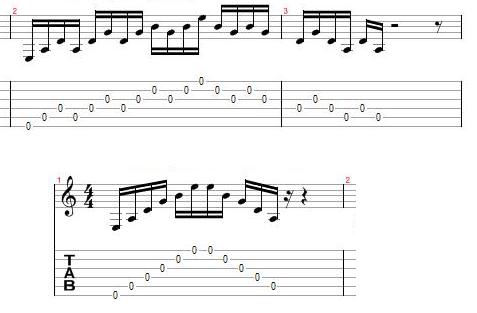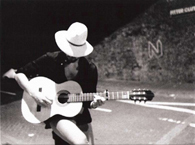Welcome to one of the most active flamenco sites on the Internet. Guests can read most posts but if you want to participate click here to register.
This site is dedicated to the memory of Paco de Lucía, Ron Mitchell, Guy Williams, Linda Elvira, Philip John Lee, Craig Eros, Ben Woods, David Serva and Tom Blackshear who went ahead of us.
We receive 12,200 visitors a month from 200 countries and 1.7 million page impressions a year. To advertise on this site please contact us.
|

|
|
Picado with I and M
|
You are logged in as Guest
|
|
Users viewing this topic: none
|
|
Login  | |
|

   
Ramon Amira
Posts: 1025
Joined: Oct. 14 2009
From: New York City

|
 Picado with I and M Picado with I and M
|
|
|
I have a suggestion for anyone who might be interested in experimenting with it, with respect to alternating when playing picado. I developed a method for myself when learning guitar, and now use it with my students with great success. I came to the conclusion that when playing picado with I and M, it is more fluent and secure if you always use M when ascending to a higher string, and always use I when descending to a lower string. Think about it – you wouldn't dream of playing an ascending arpeggio on 3-2-1 by ascending with A-M-I – it would be incredibly cumbersome and unnatural, because I-M-A very naturally fall on 3-2-1. It's really the identical thing. M naturally falls to the next higher string from I. That's because M is longer than I, which makes it awkward to ascend with I instead of M. Play apoyando very slowly and take a look at your right hand fingers as you ascend. If you play the third string apoyando with M, it comes to rest, however momentarily, on the fourth string. So now M is on the fourth string and you have to reach up with the shorter finger I across the third string to the second string. It's cumbersome. Now reverse it. Play the third string apoyando with I. Now with I resting on the fourth string see how easy and natural it is to play the second string with M. M goes right to it. You don't even get a sense of reaching or stretching. And the same thing happens descending.
Try it slowly, and you will see immediately that when you ascend to the next string with I, there is a sense of "reaching" upward unnaturally. Then ascend with M, and you will see how easily and naturally the movement flows. Then do the same thing descending. Descending to the next string with I is more fluent than with M. So I always ascend with M and always descend with I. However, this imposes certain fingering revisions and requirements, that fortunately are easily met. Sometimes the next note falling on the next string down or up might not fit into that scheme. This is solved by simply taking the note on a different string. To take the most elementary example, play a one octave descending C scale in the first position. If you play the C on the second string with I, you can descend perfectly according to this method, until you come to C on the fifth string. At that point you would have to descend with M, and that breaks the pattern. Instead, if you take the D on the fifth string instead of the open fourth, you can maintain a perfect alternation, and descend to the fifth string with I playing D after M has played the E on the fourth string. The left hand fingering would have to change as well – you would play F with 2 and E with 1, and of course D with 4 and C with 2. This is just a simple example for purposes of illustration, but you can extrapolate from that to any and every run, and utilize the same principle. This might not be for everyone, but it might help some to play picado faster and more fluently.
_____________________________
Classical and flamenco guitars from Spain Ramon Amira Guitars
|
|
|
|
REPORT THIS POST AS INAPPROPRIATE |
Date Jun. 5 2010 20:03:47
 |
|

   
Ramon Amira
Posts: 1025
Joined: Oct. 14 2009
From: New York City

|
 RE: Picado with I and M (in reply to Ramon Amira) RE: Picado with I and M (in reply to Ramon Amira)
|
|
|
Right Richard, though these patterns might not be the best to illustrate what I'm suggesting as something to possibly at least take a look at and try. These patterns are closer to arpeggio patterns, and have intervening notes left out. A typical flamenco picado run will go scale-wise, and that's where you almost always will have to ascend with I and descend with M at several points. Certainly, as Orsonw points out, you can train your fingers to cross using either finger, which generally entails having a little bit more bend in M to compensate for the length, so it's a matter of choice. I just happened to have started doing my pattern very early in my training, and it worked well, so I teach it to my beginning students. But as with just about all aspects of technique, you can do many things in different ways, and if you practice any given way diligently enough, you will become proficient. But I have had intermediate and some advanced students who were not entirely satisfied with their picado, and many of them improved after adopting this pattern. As I said originally, it might not be for everyone, but for anyone who is dissatisfied with his picado, it's worth at least trying.
_____________________________
Classical and flamenco guitars from Spain Ramon Amira Guitars
|
|
|
|
REPORT THIS POST AS INAPPROPRIATE |
Date Jun. 6 2010 9:21:55
 |
|

   
mark indigo
Posts: 3625
Joined: Dec. 5 2007

|
 RE: Picado with I and M (in reply to Ramon Amira) RE: Picado with I and M (in reply to Ramon Amira)
|
|
|
quote:
These patterns are closer to arpeggio patterns, and have intervening notes left out.
no they don't, they are string crossing exercises, the idea is to play them with i m picado rest stroke.
each note is on a different string, which means you have to string cross constantly, yes, even the "difficult" way m i ascending and i m descending
instead of avoiding "awkward" string crossing, practise it until it is as easy as the "easy" string crossing....
quote:
it is more fluent and secure if you always use M when ascending to a higher string, and always use I when descending to a lower string ...... However, this imposes certain fingering revisions and requirements,
what happens when you improvise?
|
|
|
|
REPORT THIS POST AS INAPPROPRIATE |
Date Jun. 8 2010 1:29:06
 |
|
 New Messages New Messages |
 No New Messages No New Messages |
 Hot Topic w/ New Messages Hot Topic w/ New Messages |
 Hot Topic w/o New Messages Hot Topic w/o New Messages |
 Locked w/ New Messages Locked w/ New Messages |
 Locked w/o New Messages Locked w/o New Messages |
|
 Post New Thread
Post New Thread
 Reply to Message
Reply to Message
 Post New Poll
Post New Poll
 Submit Vote
Submit Vote
 Delete My Own Post
Delete My Own Post
 Delete My Own Thread
Delete My Own Thread
 Rate Posts
Rate Posts
|
|
|
Forum Software powered by ASP Playground Advanced Edition 2.0.5
Copyright © 2000 - 2003 ASPPlayground.NET |
0.09375 secs.
|


 Printable Version
Printable Version








 New Messages
New Messages No New Messages
No New Messages Hot Topic w/ New Messages
Hot Topic w/ New Messages Hot Topic w/o New Messages
Hot Topic w/o New Messages Locked w/ New Messages
Locked w/ New Messages Locked w/o New Messages
Locked w/o New Messages Post New Thread
Post New Thread